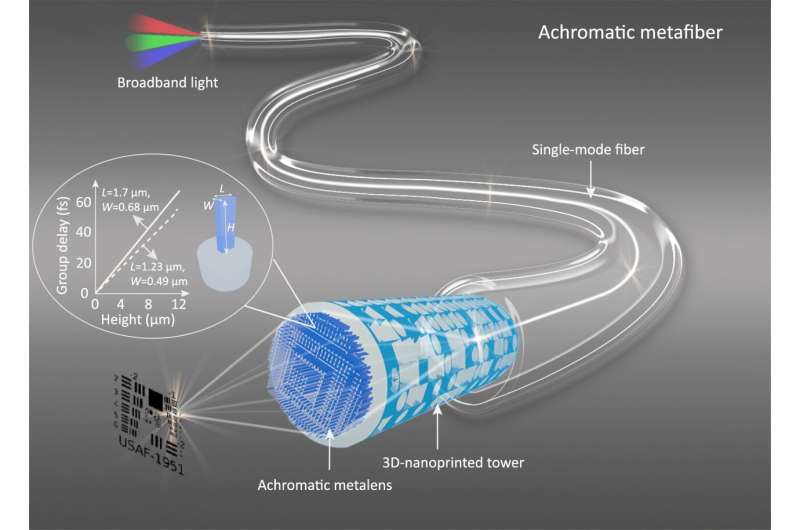Compact and flexible fiber design ensures efficient focusing and razor-sharp images thanks to 3D printing

An interdisciplinary team of researchers from Korea, Australia, Great Britain, and Germany—with participation of Leibniz Institute of Photonic Technology (Leibniz IPHT)—were able for the first time to optimize an optical glass fiber in such a way that light of different wavelengths can be focused extremely precisely. The level of accuracy is achieved by 3D nanoprinting of an optical lens applied to the end of the fiber.
This opens up new possibilities for applications in microscopy and endoscopy as well as in laser therapy and sensor technology. The researchers published their results in the journal Nature Communications.
Lenses at the end faces of optical fibers currently used in endoscopy for medical diagnostics have the disadvantage of chromatic aberration. This imaging error of optics, caused by the fact that light of different wavelengths, i.e., different spectral colors, is shaped and refracted differently, leads to a shift in the focal point and thus to blurring in imaging over a wide range of wavelengths. Achromatic lenses, which can minimize these optical aberrations, provide a remedy.
Meta lens for exact light focusing
Such an achromatic lens, a so-called meta lens, which is attached to the end of an optical fiber and allows focusing and imaging of minute details with depth-of-field imaging, has now been realized for the first time by an international team.
"For ideal light shaping and achromatic focusing, we realized an ultrathin polymer-based lens, which consists of a complex design of geometric structures in the form of nanopillars. This structure was printed directly on the tip of a 3D-printed hollow tower structure on one of the end faces of a commercial optical fiber. In this way, optical fibers can be functionalized in such a way that light can be focused very efficiently on a focal point and images with high resolution can be generated," explains Prof. Dr. Markus Schmidt, head of the Fiber Photonics Department at Leibniz IPHT, who co-developed the optical lens.
The meta lens realized by the researchers has a lens diameter of 100 micrometers and a numerical aperture (NA) of 0.2, which is significantly higher compared to previously used achromatic lenses on the end of fiber end faces and thus achieves better resolution. The lens allows optical aberrations to be corrected and light in a spectral bandwidth of 400 nanometers in the infrared range to be focused very precisely.
"It is remarkable that the individual nanopillars have different heights ranging from 8.5 to 13.5 micrometers. This allows the different wavelengths of light to be focused on a single focal point," says Prof. Dr. Markus Schmidt.
In experimental studies, the researchers were able to demonstrate the lens and focusing efficiency of the developed fiber optics using fiber-based confocal scanning imaging as an example: Using a fiber with achromatic meta-optics, they achieved convincing image quality with high image acquisition efficiency and high image contrast at different wavelengths. The focus positions remained almost constant even at different wavelengths.
Optimal light shaping for a wide range of applications
"Since the developed nanostructured meta lens is extremely small and flat, a fiber optic design with achromatic optics at the top offers the potential to further advance miniaturized and flexible endoscopic imaging systems based on fiber technology and to enable even more gentle minimally invasive examinations," Prof. Dr. Markus Schmidt explains a possible application scenario.
In addition to this main area of application, the researchers see further areas of application in the field of laser-assisted therapy and surgery, in fiber-optic communication and fiber sensor technology.
More information: Haoran Ren et al, An achromatic metafiber for focusing and imaging across the entire telecommunication range, Nature Communications (2022). DOI: 10.1038/s41467-022-31902-3
Journal information: Nature Communications
Provided by Leibniz Institute of Photonic Technology



















